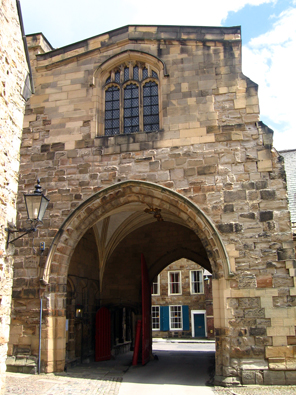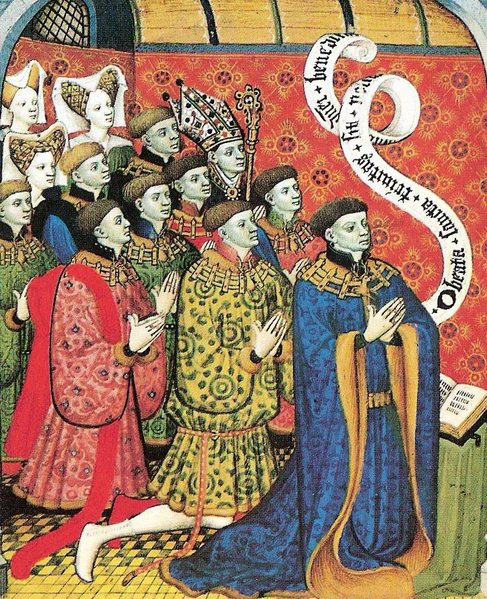The custom of choosing a boy to act as ‘Bishop’ for one or more days each year, often with a considerable element of parody, was familiar throughout western Europe in the later Middle Ages. The Boy Bishop of Durham was chosen from among the children of the Almonry School, founded around 1340, whose schoolroom was next to the Abbey Gate (see illustration below), and hundreds of contributions towards the cost of the custom are recorded in the accounts of officials of the cathedral priory from 1346-7 onwards. In most places the ceremony took place either on St. Nicholas’s day (6th December) or on Holy Innocents’ day (28th December), but at Durham (uniquely so far as we know) it was in the early summer, around Ascension or Pentecost.

The Hostillar’s account for the period beginning about 7th June, 1405 records that the Almonry Bishop ceremony was cancelled in that year ‘because it did not happen because of the wars at that time’; this is confirmed by a cancelled payment in the Chamberlain’s account which ends around 1st June. The only military campaign in the North of England in 1405-6 was Archbishop Scrope’s rebellion against King Henry IV in May 1405. Scrope was opposed by a force hurriedly recruited in Durham by Ralph Neville, first Earl of Westmorland (illustration below), with whose family the Priory had a close and long-standing relationship. Neville’s forces defeated a small local force at Topcliffe, North Yorkshire, probably on 25th May, and then confronted Scrope at Shipham Moor, near York, where there was an uneasy stalemate for three days. On May 29th Neville captured the rebel leaders by means of a treacherous ruse, and they were executed at York on June 8th, after which the Durham force seems to have returned home, leaving the King’s army to complete the task of capturing the castles of his enemy, the Earl of Northumberland. So far as Durham was concerned, the whole campaign cannot have lasted longer than a month or so, and this implies that the Boy Bishop ceremony was probably part of the celebration of Ascension week (25th-28th May) or Pentecost (7th June).

The fullest account of rites and ceremonies at Durham just before the dissolution of the monastery in 1540 is to be found in The Rites of Durham, composed by an aged and disgruntled catholic in 1593. Surprisingly, this does not mention the Boy Bishop at all, despite the fact that contributions from priory office holders under this heading continue until 1537-8, but it does give details of annual processions on the Monday, Tuesday and Wednesday preceding Ascension Day, from the cathedral to the three city churches of St. Nicholas’, St. Oswald’s and St. Margaret’s, and adds that at the end of each procession a sermon was delivered by one of the monks in the relevant church. However, in 1475 there had been a reorganisation, after which Boy Bishop payments were made to the Feretrar (the keeper of the shrine of St. Cuthbert) rather than to the Almoner. There is a complete list of Boy Bishop receipts in the next surviving Feretrar’s account (for 1480-1), but he has no corresponding outgoings, so it seems probable that the participation of the children came to an end in 1475, after which the processions continued but the Boy Bishop payments became no more than a tax levied by the Feretrar on the other priory officers.

We do not know what the duties of the Boy Bishop were before 1475, but it seems most likely that he led the Ascension week processions to the city churches and delivered a sermon there which he had learned by heart (presumably one written for him by one of the monks), as is done in some southern European child-priest ceremonies today.
The association of the Boy Bishop of Durham with the Ascension week processions is also supported by the highly unusual custom at St. Oswald’s of a parish ‘Bishop of Elvet’ (or Episcopus puerilis ecclesie Sancti Oswaldi ‘Boy bishop of the church of St. Oswald’, as he is called in the Elvethall account for 1430-31). The earliest record of the ‘Bishop of Elvet’ is in the Prior of Finchale’s account which ends on the Monday after Ascension in 1424, and he then appears sporadically in the three sets of accounts which had connections with St. Oswald’s parish (those of the Hostillar, the Prior of Finchale and the Elvethall manorial accounts) until 1474; the custom then returns for a single year in 1478-9 but never appears after that.

It looks as if Durham’s two boy bishops were connected: there are no payments for either of them during the priory’s financial crisis in 1438-40, and the generally smooth sequence of both of them comes to an end after 1474. However, contributions for the ‘Bishop of Elvet’ from the manor of Elvethall continue to appear in some years in which there are no payments for the Boy Bishop of Durham (1459-60, 1463-4, 1465-6 and 1478-9); this may suggest either that the parish of St. Oswald’s was capable of conducting its own (possibly modified) ceremony even without the Almonry bishop or that the Elvethall payments for each of these years is a ‘ghost’ mechanically copied from the preceding year. If the Almonry Bishop processed to the city churches and delivered the sermon, the Bishop of Elvet may have sung part of the liturgy, although he would not have been permitted to consecrate or dispense the Host.
So far as we know, the two Boy Bishop customs practised at Durham did not include any lack of seriousness or reverence, and they may even have been used to remind the faithful of Jesus’ instruction in Matthew 19.14: ‘Suffer little children and forbid them not to come unto me, for of such is the kingdom of heaven’.

* This month’s flower is very kindly provided by REED: Durham’s co-editor (with Mark Chambers) John McKinnell.
